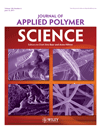Preparation of monodisperse magnetic polystyrene microspheres and its surface chemical modification
Abstract
Monodisperse magnetic polystyrene (PS) microspheres were prepared in the presence of PS seed particles and styrene-based magnetic colloid by the method of magnetic colloid swelling polymerization. The PS seed particles were prepared in advance by soap-free emulsion polymerization. Styrene-based magnetic colloid was used for swelling the PS seed particles in the magnetic colloid swelling polymerization process. After polymerization, functional amino groups were introduced onto the surface of the magnetic PS microspheres by surface Friedel-Crafts acylation reaction. The morphology, size distribution, and magnetic properties of magnetic PS microspheres were characterized with scanning electron microscopy (SEM) and vibrating sample magnetometer (VSM), respectively. SEM showed that the magnetic PS microspheres had an average size of 1078 nm with a narrow size distribution. VSM showed that the magnetic PS microspheres were superparamagnetic, and saturation magnetization was found to be 5.714 emu/g. The concentration of functional amino groups on the surface of magnetic PS microspheres was measured by atomic absorption spectroscopy and UV−Vis spectroscopy, and the concentration of amino groups was found to be 0.168 mmol/g. © 2011 Wiley Periodicals, Inc. J Appl Polym Sci, 2011




